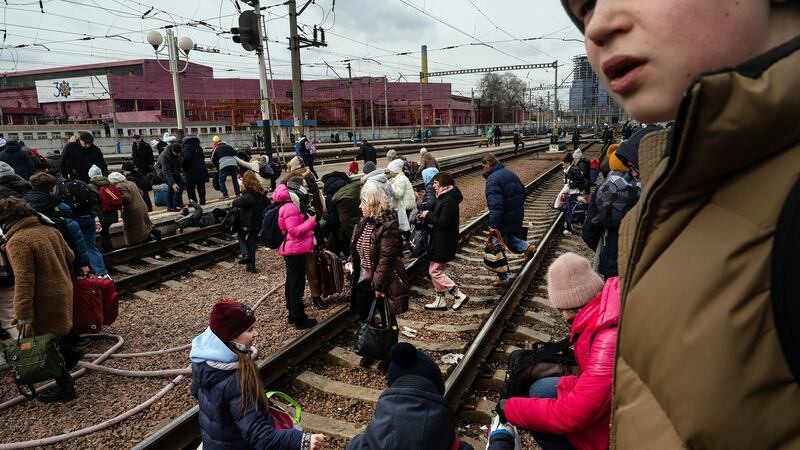Lidiia (85) shuffled through the Lviv train station in western Ukraine as a wave of faster-moving travelers rushed past. Bent over almost double from a spinal disorder, her eyes were on the floor as she tried to keep up with her son, a few steps ahead.
But her mind, she said, was on the village she had fled and the daughter she could not save when a Russian bombardment destroyed her house. Before the war came, Lidiia had lived peacefully in the farming village of Dovhenke, near Izyum, with her 61-year-old daughter, Iryna, who was paralyzed, and her two grandsons. Three weeks ago, the Russians starting bombing the village: the school, shops and homes.
Lidiia and her son spoke on the condition their last names not be used, for fear of Russian reprisals. At about 1.30 am on March 26th, Lidiia got out of bed, freezing, to put more wood in the iron stove. Her daughter was asleep. They were alone. Her son, Volodia (62), was sheltering at a friend’s house. One of her grandsons had been injured in a bombing the day before and was in a hospital. His brother was with him.
Then explosions sounded and the house started to shake. The roof came apart above Iryna. “The ceiling fell and it all came down on her,” Lidiia said. “She was shouting, ‘Mom, save me!’” There was no electricity. Lidiia tried to make her way in the dark toward her daughter’s bed, but she stumbled and fell.
‘I’m suffocating’
“I got up and then I fell, I got up and fell, and then I crawled to her,” she said. “She was saying, ‘Quick, hurry up, I’m suffocating,” Lidiia said, wiping her eyes with the edge of the mauve skirt she wore over flannel pajama bottoms.
The only light in the room came from the stars, visible through the hole in the roof, Lidiia said. She recalled painfully trying to move fallen wooden beams and chunks of clay from on top of her daughter. “She kept saying, ‘Quickly, quickly,” Lidiia said. “I told her, ‘I can’t do it quickly. I don’t have the strength.’”
Lidiia did what she could, removing small pieces of debris covering her daughter until the sun rose. In the morning, a neighbour arrived, removed the biggest pieces of wood and rubble and wrapped Iryna in a blanket. She was still breathing, but her hands and feet were blue. They took her to a relative’s house, but with the shelling, there was no way to get her treated.
“If she lives, she lives,” Lidiia said her doctor told her. She died the next day. Slow deaths such as Iryna’s have received less attention than other horrors of the war – civilians who were found shot dead with their hands bound in places such as Bucha or the bombing of a maternity hospital and a theater in Mariupol.
Lidiia blamed her daughter’s death on her hands, weakened by age and arthritis, and the curved spine that would not allow her to stand up straight. “What can I say? My daughter perished,” she said, crying softly as she sat next to plastic bags holding her belongings. “If it weren’t for me, she would have survived.”

Types of rockets
At the train station in Lviv, the mother and son were on their way to stay with friends in Khmelnytski, in central Ukraine. Volodia, with the expertise honed by years familiar with the conflict between Russian-backed separatists, recounted the types of rockets that he said rained down on their village: “They fired mortars and started to hit us with Grads, Smerch, Uragan.”
“My house was demolished, the barn was demolished. My car burned,” he said. “I had everything, and now I have nothing.”
This article originally appeared in The New York Times.










